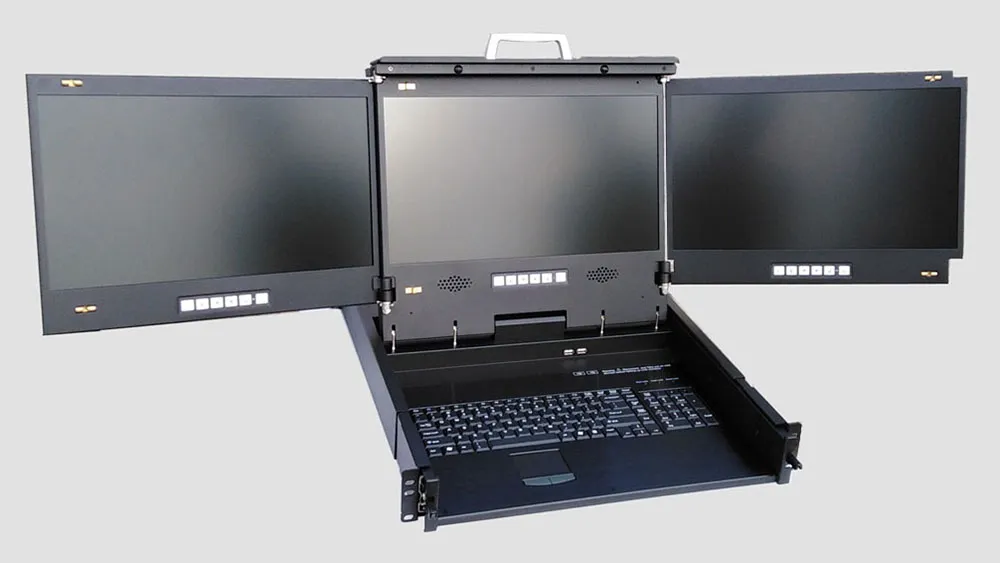LCD Monitor Drawers vs Rack Mount Panels: Which to Choose?
When setting up an efficient IT infrastructure, data center, or military-grade control system, choosing the right display solution is critical. Among the most popular options are LCD Monitor Drawers and Rack Mount Panels. While both serve the same purpose of providing visual display in rack-mounted environments, they differ significantly in design, usability, and application.
In this guide, we’ll break down the differences, benefits, and best-use cases for LCD Monitor Drawers versus Rack Mount Panels, so you can confidently choose the right option for your setup.
What Are LCD Monitor Drawers?
An LCD Monitor Drawer is a rack-mounted solution where the monitor is integrated into a sliding drawer mechanism. Typically, it comes with a foldable LCD screen and often a built-in keyboard and touchpad.
When not in use, the drawer can be neatly tucked back into the rack, saving space and protecting the monitor from dust, accidental damage, or exposure to environmental factors.
Key Features of LCD Monitor Drawers:
- Slide-in design for space-saving efficiency.
- Integrated keyboard & touchpad for all-in-one control.
- Foldable LCD screen that tucks away when not needed.
- Locking mechanisms for security in rugged or sensitive environments.
LCD Monitor Drawers are ideal for IT administrators who need quick, convenient access to rack-mounted systems without dedicating permanent space to a display.
What Are Rack Mount Panels?
Unlike drawers, Rack Mount Panels are fixed LCD monitors installed directly into the rack. These panels do not slide in and out; instead, they remain visible at all times. They’re designed for continuous monitoring and are often built to withstand harsh environments.
Rack Mount Panels come in various sizes and resolutions, making them suitable for 24/7 operations in military, industrial, or telecom applications.
Key Features of Rack Mount Panels:
- Fixed installation for always-on visibility.
- Rugged build for industrial or military use.
- Wide viewing angles & high brightness options for continuous monitoring.
- Multiple connectivity options (VGA, HDMI, DVI, DisplayPort, etc.).
Rack Mount Panels are perfect for environments where monitoring must be uninterrupted, and there’s no need for foldable or hidden setups.
LCD Monitor Drawers vs Rack Mount Panels: Side-by-Side Comparison
| Feature | LCD Monitor Drawers | Rack Mount Panels |
| Space-Saving | Excellent (slides in/out) | Takes up fixed rack space |
| Accessibility | Best for occasional use | Best for constant monitoring |
| Durability | Moderate (protected when closed) | High (built for rugged use) |
| Ease of Use | Convenient for IT admins | Reliable for continuous operators |
| Cost | Generally lower | Higher for rugged, industrial-grade panels |
| Applications | Data centers, IT racks, labs | Military, industrial, telecom, broadcast |
When to Choose an LCD Monitor Drawer
You should choose LCD Monitor Drawers if:
- You’re working in a space-constrained environment.
- You need occasional access to rack-mounted systems.
- You want an all-in-one solution (monitor + keyboard + touchpad).
- Your priority is portability and protection when not in use.
For example, in a corporate data center where IT staff occasionally need to troubleshoot or configure servers, an LCD Monitor Drawer is a practical choice.
When to Choose a Rack Mount Panel
Opt for Rack Mount Panels if:
- You require constant system monitoring (24/7 operations).
- You work in defense, industrial, or telecom environments.
- You need rugged durability for vibration, temperature, or environmental stress.
- Your team needs a dedicated, always-visible display.
For instance, in military command centers or industrial control rooms, Rack Mount Panels provide the resilience and reliability required for mission-critical operations.
Pros and Cons
LCD Monitor Drawers
✅ Space-saving, compact design
✅ Cost-effective for IT environments
✅ Integrated keyboard and mouse
❌ Not ideal for 24/7 monitoring
❌ May wear out with frequent drawer use
Rack Mount Panels
✅ Always available for real-time monitoring
✅ Rugged, military/industrial-grade durability
✅ Supports high brightness and wide temperature ranges
❌ More expensive
❌ Occupies fixed rack space
FAQs
1. Can I use both LCD Monitor Drawers and Rack Mount Panels in the same setup?
Yes. Many organizations use LCD Monitor Drawers for IT access and Rack Mount Panels for continuous monitoring, depending on operational needs.
2. Are LCD Monitor Drawers durable enough for industrial environments?
While they’re sturdy, they’re better suited for IT and data centers. For industrial or military use, Rack Mount Panels are the better choice.
3. Do Rack Mount Panels support touch screens?
Yes. Many modern Rack Mount Panels come with touchscreen functionality for interactive use.
4. Which is more budget-friendly?
LCD Monitor Drawers are generally more affordable. Rack Mount Panels cost more due to their rugged build and advanced features.
Conclusion
Choosing between LCD Monitor Drawers and Rack Mount Panels ultimately depends on your needs. If you’re working in a data center with limited space and occasional access requirements, LCD Monitor Drawers offer the perfect balance of compactness and functionality. On the other hand, if your operations demand continuous, rugged, and reliable monitoring, Rack Mount Panels are the clear winner.
Both solutions have unique advantages, and many organizations use them in combination for maximum efficiency. By carefully assessing your space, budget, and operational demands, you can select the best option for your environment.






